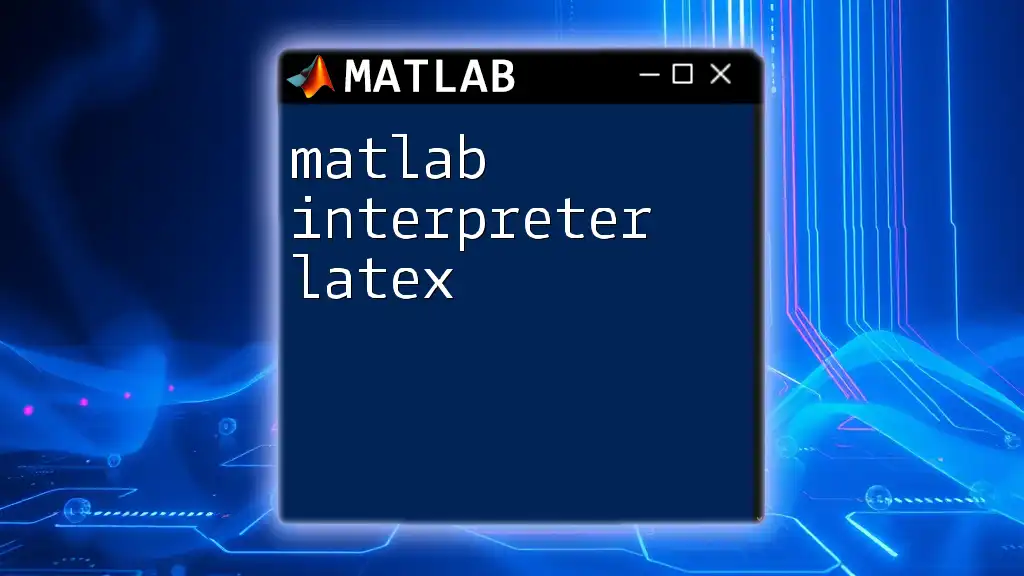In MATLAB, an integer is a whole number that can be represented by various types such as `int8`, `int16`, `int32`, and `int64`, as well as their unsigned counterparts, which allow for efficient storage and processing of numeric data.
Here's a simple example of declaring an integer variable in MATLAB:
% Declare a 32-bit integer
myInteger = int32(10);
What is an Integer in MATLAB?
Definition of an Integer
In MATLAB, an integer is a data type that represents whole numbers without any decimal places. Understanding the concept of integers is essential, especially in mathematical computations where precision and the type of data being processed matter.
For instance, while \( -2 \), \( 0 \), and \( 15 \) are integers, values such as \( 3.14 \), \( -1.2 \), and \( 5.0 \) are considered non-integers because they include decimal points. Recognizing the difference is crucial when working with various MATLAB functions that require specific data types.
Types of Integers in MATLAB
MATLAB supports various types of integer data based on the size and signedness of the values they represent. These integer types include:
- int8: A signed integer type that ranges from -128 to 127. Its compact size makes it useful for memory optimization in large datasets where only small integers are needed.
- int16: This signed integer can hold values between -32,768 and 32,767. It's generally used when larger numbers are expected but memory conservation is still necessary.
- int32: With a range from -2,147,483,648 to 2,147,483,647, this type is excellent for applications requiring a broader range of integer values.
- int64: The largest signed integer type available, ranging from -9,223,372,036,854,775,808 to 9,223,372,036,854,775,807. Suitable for extreme cases requiring significant integer representations.
In addition to signed integers, unsigned integers are also available:
- uint8: Ranging from 0 to 255, these are particularly used for representing pixel values in images.
- uint16: This unsigned variant can hold values from 0 to 65,535.
- uint32: With a range of 0 to 4,294,967,295, it's used in various applications needing non-negative values.
- uint64: This type operates within the range of 0 to 18,446,744,073,709,551,615, allowing for significantly larger representations without negative values.

Creating Integer Variables in MATLAB
Using the `int` Function
To create integer variables in MATLAB, you can use the built-in `int` function. This function allows you to define the type of integer you want. Here’s a quick example:
a = int32(123);
In this case, `a` is now a 32-bit signed integer assigned the value of 123.
Direct Assignment
Another straightforward method to create integer variables is through direct assignment of integer values to variables. For example:
b = int16(456);
Here, `b` is declared as a 16-bit signed integer.
Converting Other Data Types to Integers
There may be scenarios where you need to convert values from other data types, such as double or single, to integers. MATLAB truncates the decimal portion when performing this conversion. Here’s how you can do that:
c = int8(5.7); % Result will be 5
In this example, the fractional part has been discarded, and `c` now holds the integer 5.

Basic Operations with Integers
Arithmetic Operations on Integers
Performing arithmetic operations on integers is straightforward in MATLAB. The basic operations include addition, subtraction, multiplication, and division. Here’s a simple example of addition:
a = int32(12);
b = int32(7);
result = a + b; % result will be 19
Comparison Operators
Integers can also be compared using comparison operators. This can be essential when making decisions in code based on integer values:
if a > b
disp('a is greater than b');
end
In this code snippet, if `a` is indeed greater than `b`, it will display the message.
Logical Operations
MATLAB allows you to execute logical operations on integer values. For instance, you can check if two integers are equal:
isEqual = (a == b); % Returns false, as a is not equal to b

Advanced Integer Operations
Integer Overflow and Underflow
Integer overflow occurs when an operation results in a value greater than the maximum limit of the integer type, while underflow is essentially the opposite, when a value drops below its minimum. For instance:
d = int8(127) + int8(1); % Result: -128 due to overflow
In this case, adding 1 to the maximum value of an `int8` leads back to the minimum limit, demonstrating the cyclical nature of integer overflow.
Using Integer Arrays
Creating arrays of integers is a common practice in MATLAB, especially for computational tasks. Here’s how to create an array of integers:
arr = int16([1, 2, 3, 4]); % Creating an array of int16
This array can be utilized efficiently in operations and functions expecting integer types.
Performance Considerations
Choosing the right integer type can significantly impact performance in MATLAB applications. Smaller integer types (like `int8` and `uint8`) can save memory, particularly when working with large arrays, while larger types (like `int64`) may be necessary for calculations requiring greater precision or range. Always consider your application's demands when selecting integer types.

Common Pitfalls When Working with Integers
Rounding Issues
When converting from a floating-point number to an integer, rounding issues can occur. For example:
e = int32(3.8); % Result will be 3
The value \(3.8\) is truncated to yield \(3\), which may not always be the intended effect in certain calculations.
Misunderstanding Integer Limits
It is crucial to understand the limits of each integer type to avoid overflow and underflow errors. Here’s a quick summary table for reference:
- int8: -128 to 127
- int16: -32,768 to 32,767
- int32: -2,147,483,648 to 2,147,483,647
- int64: -9,223,372,036,854,775,808 to 9,223,372,036,854,775,807
- uint8: 0 to 255
- uint16: 0 to 65,535
- uint32: 0 to 4,294,967,295
- uint64: 0 to 18,446,744,073,709,551,615
Understanding these limits will help you write more robust and error-free code.

Practical Applications of Integers in MATLAB
Using Integers in Image Processing
Integer types are fundamental in image processing, where pixel values are typically represented as integers. For instance, when creating a monochrome image, you might have:
img = uint8(zeros([100, 100])); % Creating a 100x100 black image
img(50,50) = 255; % Setting a pixel to white
In this example, a black image is created, and then a pixel is set to white by assigning the maximum value for an 8-bit unsigned integer.
Integer-Based Algorithms
Various algorithms in computer science, especially sorting algorithms, effectively leverage integer data types. For example, sorting an array of integers can be efficiently performed with:
sortedArray = sort(int32([3, 1, 4, 2])); % Integer sort
This retains the integer properties while facilitating ordered data processing.

Conclusion
Understanding and effectively utilizing the MATLAB integer type can significantly enhance your programming efficiency and data accuracy. By grasping the differences between various integer types, their creation, operations, and applications, you can leverage MATLAB's capabilities to tackle complex computational problems successfully.

Additional Resources
For further reading and exploration of integers in MATLAB, consider checking the official MATLAB documentation on integer types and additional tutorials covering both basic and advanced topics relevant to MATLAB programming.

Call to Action
We encourage you to share your experiences with MATLAB integers. Have any questions or insights? Let us know in the comments below!

















